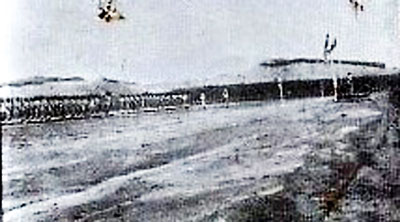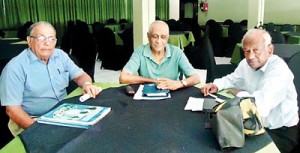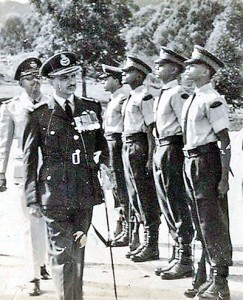Diyatalawa: Taking off from the very beginning
View(s):Three Air Force veterans are on a mission to write a book on the oldest training station of the SLAF that will tell the tale of one big family-from the cook to the pilot to the Air Force Commanders. Here they speak to Renuka Sadanandan
Diyatalawa’s size belies its importance. The picturesque little town sandwiched between Bandarawela and Haputale in the Badulla district, has a virtually umbilical connection with the Sri Lanka Air Force – it is where the first formative days in the force unfold for the new recruits at the Ground Combat & Recruit Training Unit of the Sri Lanka Air Force (SLAF).

The parade square at Diyatalawa
For three senior officers of the SLAF, Air Vice Marshal Brendan Sosa (retd), Wing Commander E.H. Ohlums (retd) and Wing Commander Ranjit Ratnapala (retd) those golden days at Diyatalawa are a very real memory, even 50 years after and they believe this connection must live in the hearts of all Airmen. For them, their shared history dates all the way back to the early 1960s, when the three of them were at Diyatalawa as young Air Force officers. They would, all three go on to be Commanding Officers of the Diyatalawa Base.
Many books have been written in recent times on the Air Force and the role it has played in the ending of the 30-year conflict. For these three Air Force veterans, however, there remains another saga they feel needs to be told and which they are now preparing to write a book about.
The Air Force is not made up of only pilots, says Wing Commander Ratnapala. He is referring then to all who constitute the Air Force– from the cook to the pilot to the Air Force Commanders. “They are all one big family. Pride of place is usually given only to pilots, we must write including all these people, even the cook who made the in-flight rations for the pilots,” he says.

At the first book meeting in August: (from left) Wing Commander E.H. Ohlums, Air Vice Marshal “Bren” Sosa and Wing Commander Ranjit Ratnapala
Their book they envisage, will focus on two aspects: The SLAF Regiment, and Diyatalawa which is the oldest training station of the SLAF. As the main Ground Combat Training Base of the SLAF, the Diyatalawa base provides basic combat training for all ranks and advanced training for SLAF Regiment officer cadets and gunners as well as a host of training courses.
The history of the Diyatalawa camp is integral to their story and they are now searching and sifting through the information they have about how this quaint hillside town became such an important Air Force base. Records indicate that it was around 1885 that the British Army established a garrison at Diyatalawa and it came into prominence when at the turn of the century the British used it as an internment camp for the Boer Prisoners of War and subsequently for World War 1 prisoners. After independence in 1948, it was given over to the Ceylon Army. When the Royal Ceylon Air Force was established in 1951, a part of the camp was given over to the nascent organization. On October 15, 1952, the Royal Ceylon Air Force established a unit at the Stable Hill Camp with officers and instructors seconded from the Royal Air Force Regiment. It was called Stable Hill, simply because it had once housed the stables.
“Stable Hill camp was where anyone joining the Air Force was trained. You first set foot on Stable Hill camp, you didn’t go anywhere else,” says Air Vice Marshal Sosa.
In 1953, another building put up by a British couple in memory of their son or sons (they are checking this) who were killed in the war, McRobert Camp was taken over by the RCyAF from the RAF and made the Officers’ Mess. In 1971 it was handed over to the Ministry of Health and is now the Base Hospital, Diyatalawa. The hundreds who seek treatment there probably have no inkling that it was once a very vibrant part of the Air Force camp.

The first ceremonial in ‘Blues’
“It was a showpiece building in Diyatalawa,” says Wing Commander Ratnapala.
The base aside, the public know little of the vital role played by the SLAF Regiment, which they describe as the ‘infantry of the Air Force’. “One of the main responsibilities is that the Regiment undertakes the tactical defence of airfields. There are other duties like handling internal security problems,” Wing Commander E.H. Ohlmus explains.
Going back to those early days, he says, all the pioneers who joined the Royal Ceylon Air Force were trained with the RAF, England. Before they were sent there, it was to Diyatalawa they came, to get oriented or in service parlance for ‘square-bashing’.
That initial training is a vital phase for all officers, cadets and aircraftsmen regardless of their branch or trade – it was how ‘a civilian is transformed into a disciplined serviceman’. Only on successful completion of their basic courses of training at Diyatalawa, would they qualify to proceed for further training locally and abroad, in their chosen careers, he adds.
Air Vice Marshal Sosa recalls the time in 1959 when after training in England he was posted to Diyatalawa. Squadron Leader P.D. Lee was the Commanding Officer and with Flight Sgt Anderson had introduced a systematic training process which included an agility course and assault course. “The ‘Anderson Wall’ was the culmination of the assault course. Night training ended with the crossing of ‘Leech Valley’, and the attack and defence of Lone Tree Hill.” Interestingly the ‘Anderson Wall’ is still there.
Physical fitness was stressed on with the recruits made to run up and down ‘Fox Hill’ which even today remains a Diyatalawa landmark. Train travellers look out for the familiar sight as the Udarata Menika takes the bend from Haputale. The Regiment crest is also now on a hill close to Fox Hill.
As time went on Sri Lankan officers took over the entire training regimen putting each new intake of around 100 through the drill, but the 1971 insurgency demanded a whole new batch of efficiency. With the Wellawaya police station coming under attack, then Ella and Bandarawela, the Air Force was called upon to carry out joint patrols with the Army covering these towns and the adjoining tea estates.
In May 1971, a Volunteer Air Force was to be raised and crash courses had to be carried out for the new recruits at Diyatalawa. Overnight they were called upon to train 300-400 per batch. Training was modified with therigorous physical regime eased to accommodate older recruits. Passing out parades were held every three weeks, that in itself a challenge.
The book, they hope will be able to highlight the many contributions made by the Regiment in the history of the SLAF and the people who silently served. “I have written to all the Commanding Officers, both the Diyatalawa Commanding Officers as well as the Regiment Commanding Officers asking for their input,” says Air Vice Marshal Sosa, adding that the book has the blessings of the Air Force Commander.
The book will be published by the Trust set up in memory of Squadron Leader Chinthaka Ratnapala, Wing Commander Ratnapala’s son who was killed in the war in 1997.
They hope Air Force personnel and other interested parties will come forward to furnish them with more historical and other details to enable them to present a complete picture of the Regiment and Diyatalawa right up to 2009. Any information could be sent to Air Vice Marshal Sosa at bsosa@sltnet.lk


